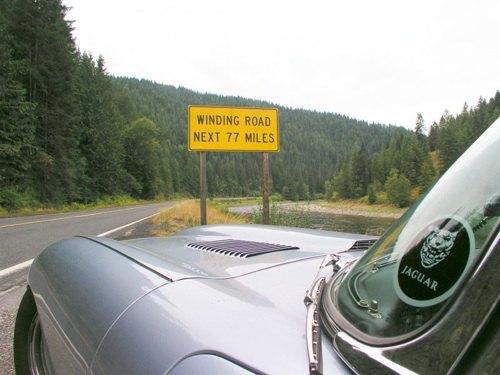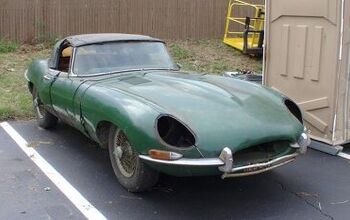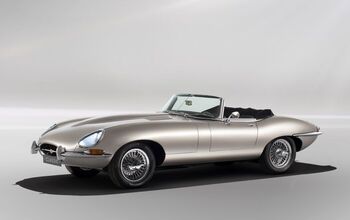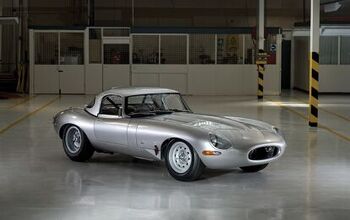Review: 1965 Jaguar E-Type

The sun breaks through trees and plays off the long bonnet. As I loaf along the arrow-straight road, I absorb the soundtrack: the baritone exhaust note of the big-bore, long-stroke, inline-six. Ahead, I spot that sign that makes every true driver shut down the internal dialog in their brain and focus on the here and now: Winding Road. Amazing what a sign can do to lift one’s spirit. In a Jaguar E-Type, elevation quickly becomes ecstasy.
The road dives down and to the left, as I blip the throttle and snap the solid shifter down from fourth into third. As the revs rise and fall the big pipe organ that droned a single note is joined by a mechanical symphony. There’s a distinctive whine from the intake, produced by three trumpeted two-inch Skinner’s Union HD8 carburetors. The entire cylinder head adds a delicious rustle: chain-driven dual overhead cams spinning furiously at the insistence of my right foot. Underlying it all: the booming low notes of the exhaust, throbbing as if The Ox himself was laying down the bass track.
The car handles corners with aplomb; I could take each one at twice the speed without so much as a squeak of complaint from the tires. But the realization that I’m driving a forty-four year old car holds me back. This car was built in a time when going fast and looking good were the priorities, not saving the planet or protecting the occupant. The E-Type’s seat rises as high as my shoulder blades. In a bad shunt, the seat belts would only serve to secure my body while the windscreen decapitated me, in the blink of an eye. No air bags or handling nanny here; the only safety systems on board are my grey matter and the skill of my hands and feet. Stirling Moss will have to wait. Fortunately, even at velocities well within the posted limits, the E-Type provides endless satisfaction. The driving experience is worth risks Ralph Nader could never even imagine.
The E-type Jaguar arrived on the automotive scene in 1961, like a cruise missile vectoring into a stone-age village. It brought with it technologies extracted from the rarified world of endurance racing, bringing world-beating performance to the street for a shockingly reasonable price.
The E-Type outperformed the contemporary Ferrari 410 SuperAmerica ($16,800) or a 250 GT Berlinetta SWB ($11,800), for less than half the price. When new, the Jaguar sold for $5,595. Il Commendatore himself labelled the E-type “The most beautiful car ever made” . . . while swiftly copying it in the form of the 250 GTO, and again with the 275&365 GTB/4s. The E-Type also prompted redesigns of other sports cars, notably here in America, Chevrolet’s Corvette; look at the radical difference between the C1 & C2.
The E-type is a race car adapted for the street, not a purpose-built race car like it’s predecessors, the C-/D-type Jaguars. The E-type appeared in a few races, with two of the first stock units topping the podium in their initial outing at Oulton Park (in their native England). But, in the end, E-Types were not that successful at the big races of the era: Le Mans, Sebring, the Nürburgring. The E-Type always finished near but never at the top of the podium.
Still, the E-Type offered truly innovative-for-the-day technology, some of which has become standard equipment across the automotive spectrum: power-assisted disc brakes, fully-independent rear suspension, unibody construction, rack and pinion steering. In the early ’60s, the E-Type was leading-edge exotica, delivered in the form of reasonably-priced automotive erotica.
Despite its long, low look, the E-Type is deceptively small, especially compared to most other cars on the road. It handles very smoothly thanks to even weight distribution fore and aft; the engine and gearbox sit back well behind the front axle so that weight, with a driver and fuel, is split 50/50. Steering is precise. Oversteer is delivered so smoothly and predictably that in a tight autocross course some steering load can be handled by the loud pedal. Diesel-like torque is available at any RPM, making 50-70+ acceleration and passing on two-lane roads something to seek out and savor.
My E-Type’s original owner purchased the car in Albuquerque, NM. About 15 years ago, my father restored it as his “retirement project” and I bought it from him in 2003 to save his marriage. (True story.) After investing countless hours behind the wheel (and under the bonnet), I can report that the Jaguar E-Type’s not the fastest classic car money can buy. Nor is it the best around a skidpad. But none of that really matters with an E-type Jaguar. The car provides masses of dynamic feedback and makes great noises. Phallic issues aside, it’s drop-dead gorgeous. When you’re heading down a twisting two lane road, when there’s nothing but zen ahead, what else do you need?

Second Generation Car Guy living in the Sasquatch-filled wooded hills of the Pacific Northwest with an old E-type Jaguar and a lawnmower that run on gasoline. Everything else I drive runs on home-brew BioDiesel.
More by Chuck Goolsbee
Latest Car Reviews
Read moreLatest Product Reviews
Read moreRecent Comments
- SCE to AUX The nose went from terrible to weird.
- Chris P Bacon I'm not a fan of either, but if I had to choose, it would be the RAV. It's built for the long run with a NA engine and an 8 speed transmission. The Honda with a turbo and CVT might still last as long, but maintenance is going to cost more to get to 200000 miles for sure. The Honda is built for the first owner to lease and give back in 36 months. The Toyota is built to own and pass down.
- Dwford Ford's management change their plans like they change their underwear. Where were all the prototypes of the larger EVs that were supposed to come out next year? Or for the next gen EV truck? Nowhere to be seen. Now those vaporware models are on the back burner to pursue cheaper models. Yeah, ok.
- Wjtinfwb My comment about "missing the mark" was directed at, of the mentioned cars, none created huge demand or excitement once they were introduced. All three had some cool aspects; Thunderbird was pretty good exterior, let down by the Lincoln LS dash and the fairly weak 3.9L V8 at launch. The Prowler was super cool and unique, only the little nerf bumpers spoiled the exterior and of course the V6 was a huge letdown. SSR had the beans, but in my opinion was spoiled by the tonneau cover over the bed. Remove the cover, finish the bed with some teak or walnut and I think it could have been more appealing. All three were targeting a very small market (expensive 2-seaters without a prestige badge) which probably contributed. The PT Cruiser succeeded in this space by being both more practical and cheap. Of the three, I'd still like to have a Thunderbird in my garage in a classic color like the silver/green metallic offered in the later years.
- D Screw Tesla. There are millions of affordable EVs already in use and widely available. Commonly seen in Peachtree City, GA, and The Villages, FL, they are cheap, convenient, and fun. We just need more municipalities to accept them. If they'll allow AVs on the road, why not golf cars?






































Comments
Join the conversation
Sled, I have two knock-offs from my dad's 1970 E-Type as paper weights on my desk. Unfortunately it is all that I have of her as dad sold her for an Alfa 2000 GTV. Frankly, a real Italian mistress would have been more dependable and less expensive. Neither, though, would have had the enduring beauty of an E-Type.
I bought a 68 ots about 5 years back and the previous owner had put a motolita steering wheel on it and that was the first thing i replaced with the restores original wheel.